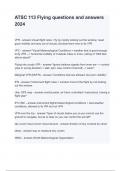Atsc 113 flying - Study guides, Class notes & Summaries
Looking for the best study guides, study notes and summaries about Atsc 113 flying? On this page you'll find 185 study documents about Atsc 113 flying.
All 185 results
Sort by
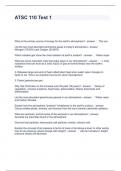
-
ATSC EXAM BUNDLE GRADED A 2024
- Package deal • 25 items • 2024
-
- $51.49
- 1x sold
- + learn more
Exam (elaborations) ATSC 110 Test 1 Questions with correct Answers 2024 Exam (elaborations) ATSC 113 - Flying Weather 1 Questions and Answers 2024 Exam (elaborations) ATSC 113 - Snow Sports Questions and Answers 2024 Exam (elaborations) atsc 113 final exam Questions and answers fully solved Exam (elaborations) ATSC 113 Final Study Question
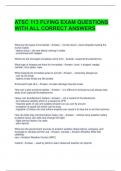
-
ATSC 113 FLYING EXAM QUESTIONS WITH ALL CORRECT ANSWERS
- Exam (elaborations) • 34 pages • 2024
- Available in package deal
-
- $12.49
- + learn more
ATSC 113 FLYING EXAM QUESTIONS WITH ALL CORRECT ANSWERS What are the types of tornadoes - Answer- - funnel cloud = cloud droplets making the funnel visible - debris cloud = dirt and debris making it visible - sometimes both happen Where do the strongest tornadoes come from - Answer- supercell thunderstorms What type of shapes are there for tornadoes - Answer- cone, v-shaped, wedge, cylinder, hour-glass, rope What hazards do tornadoes pose to aircraft - Answer- - extremely danger...

-
ATSC 113 Flying Midterm Exam Questions with All Correct Answers
- Exam (elaborations) • 20 pages • 2024
- Available in package deal
-
- $12.49
- + learn more
ATSC 113 Flying Midterm Exam Questions with All Correct Answers How does statically stable conditions affect flight - Answer- -forms near ground at night, clear skies, light winds -non-turbulent -oscillates as mountain-wave, drain into valleys, or form K-H turbulence waves How does statically neutral conditions affect flight - Answer- -overcast, mod-strong winds -non-turbulent, but wind shear can change easily -hitting mountain causes wake turbulence How does statically unstable c...
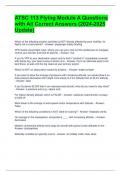
-
ATSC 113 Flying Module A Questions with All Correct Answers (2024-2025 Update)
- Exam (elaborations) • 13 pages • 2024
- Available in package deal
-
- $13.49
- + learn more
ATSC 113 Flying Module A Questions with All Correct Answers ( Update) Which of the following aviation activities is NOT directly affected by poor visibility, for flights not on instruments? - Answer- passenger safety briefing VFR means visual flight rules, where you use your view out the windscreen to navigate, control your aircraft, and land at airports. - Answer- true If you fly VFR to your destination airport only to find it "socked in" (completely covered) with dense fog, your...
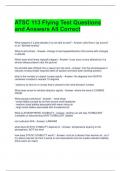
-
ATSC 113 Flying Test Questions and Answers All Correct
- Exam (elaborations) • 10 pages • 2024
- Available in package deal
-
- $12.49
- + learn more
ATSC 113 Flying Test Questions and Answers All Correct What happens if a pilot decides it is not safe to land? - Answer- pilot flies a "go around" or an "aborted landing" What is wind shear - Answer- change of wind speed/direction that comes with changes in altitude When does wind shear typically happen - Answer- it can occur at any altitude but it is almost always present near the ground Do aircrafts take off/land into or away from the wind - Answer- into the wind becau...
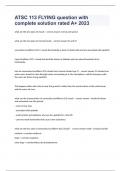
-
ATSC 113 FLYING question and answers rated A+ 2024
- Exam (elaborations) • 47 pages • 2024
- Available in package deal
-
- $13.99
- + learn more
ATSC 113 FLYING question and answers rated A+ 2024 what are the two types of clouds - correct answer normal and special what are the two types of normal clouds - correct answer CU and ST convective/cumiliform (CU) = clouds that look like a stack of cotton balls and are associated with updrafts Layer/stratiform (ST) = clouds that look like sheets or blankets and can extend hundreds of km horizontally how do convective/cumiliform (CU) clouds form (normal clouds type 1) - correct ...
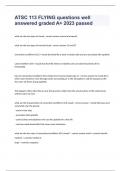
-
ATSC 113 FLYING questions with complete solution 2024
- Exam (elaborations) • 47 pages • 2024
- Available in package deal
-
- $13.49
- + learn more
ATSC 113 FLYING questions with complete solution 2024 what are the two types of clouds - correct answer normal and special what are the two types of normal clouds - correct answer CU and ST convective/cumiliform (CU) = clouds that look like a stack of cotton balls and are associated with updrafts Layer/stratiform (ST) = clouds that look like sheets or blankets and can extend hundreds of km horizontally how do convective/cumiliform (CU) clouds form (normal clouds type 1) - correct...
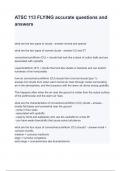
-
ATSC 113 FLYING accurate questions and answers with complete solution
- Exam (elaborations) • 44 pages • 2024
- Available in package deal
-
- $7.99
- + learn more
ATSC 113 FLYING accurate questions and answers with complete solution
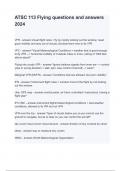
-
ATSC 113 Flying questions and answers 2024
- Exam (elaborations) • 20 pages • 2024
- Available in package deal
-
- $7.99
- + learn more
ATSC 113 Flying questions and answers 2024
ATSC 113 Flying questions and answers 2024.
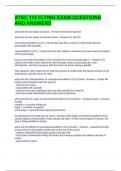
-
ATSC 113 FLYING EXAM QUESTIONS AND ANSWERS
- Exam (elaborations) • 34 pages • 2024
- Available in package deal
-
- $18.49
- + learn more
ATSC 113 FLYING EXAM QUESTIONS AND ANSWERS billow (k-h wave) - Answer-- type of special cloud caused by wind shear (change of wind speed or direction with height) in the atmosphere which causes waves to form in a layer of air where cooler air underlies warmer air - indicate wind shear and CAT - short and thin - look like an accordian - can break and cause cat eye swirls - can be high or mid - do not need mountains to form - cirrocumulus undulatus = high billow - altocumulus und...

Did you know that on average a seller on Stuvia earns $82 per month selling study resources? Hmm, hint, hint. Discover all about earning on Stuvia



